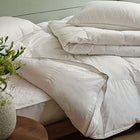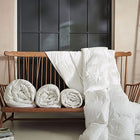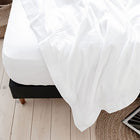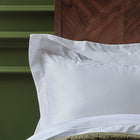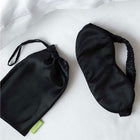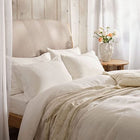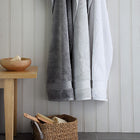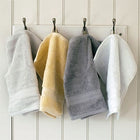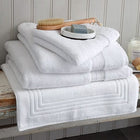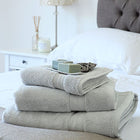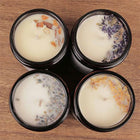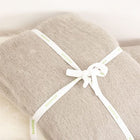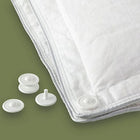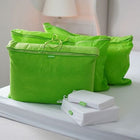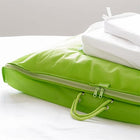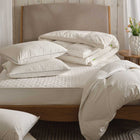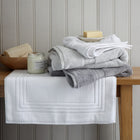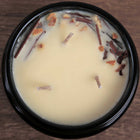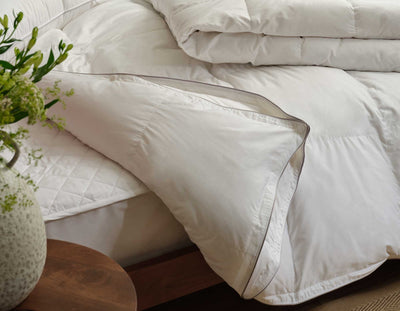
What's the best kind of wool?
Who doesn’t like wrapping a soft and cosy wool throw around themselves snuggled up in bed or on the sofa! But which type of wool is the softest and cosiest? We’ve been finding out what really is the best kind of wool...
(Ok, so we’ve listed a lot of different ‘wool’ types but if we’re being strictly factual, wool is only wool if it comes from a sheep! Alpaca, cashmere, mohair, angora and camel ‘wool’ are all really hair, not wool!)
- Wool - 11 top facts
- Sheep’s wool
- Lambswool
- Merino wool
- Shetland wool
- Alpaca
- Cashmere
- Mohair
- Angora
- Camel
Wool - 11 top facts!
Wool is a great material to use to make luxury bedding and clothing. Wool has been used in textiles since around 3000 BC due to these wonderfully useful natural characteristics:
- Wool is completely natural: Wool has a range of unique properties that synthetics can't match.
- Wool is wonderfully insulating: Wool fibres are crimped not straight which creates air pockets that retain heat.
- Wool repels water: Wool can absorb up to 50% of its weight in water without becoming saturated, helping to keep you comfortable even when damp.
- Wool is moisture wicking: The wool fibres wick sweat away from the body. As your sweat evaporates, heat is drawn away from your skin; great in hot weather but not so good when it's cold. Wool helps your perspiration to evaporate more quickly, so you stay warm.
- Wool is breathable: Wool helps your body regulate temperature; great for staying cool in the summer and warm in the winter. Which is why it's used a lot in outdoor clothing.
- Wool is resilient & elastic: Wool fibres can be stretched up to 30% and still spring back, which helps the clothing retain its shape and resist wrinkles.
- Wool is highly absorbent: Wool retains liquid easily which means it dyes richly while remaining colourfast, without the need for harsh chemical additives.
- Wool is odour-resistant: Wool is naturally more resistant to retaining odours than synthetic fabrics like polyester. Wool absorbs sweat and releases it back into the air, inhibiting bacteria growth and preventing the fabric from retaining the smell.
- Wool is hypoallergenic: Wool is naturally anti-allergy and repels dust mites, which is great for allergy sufferers.
- Wool is naturally stain-resistant, anti-static, flame-retardant and wrinkle-resistant: So there is no need to add chemical agents.
- Wool is sustainable: Wool is rapidly renewable, biodegradable, recyclable and able to be produced organically.
Sheep's wool
Wool from adult sheep is the ideal fabric for throws, bedding and winter knits not worn next to the skin as it can be itchy. It’s less expensive than many other wools.
It’s very durable, maintains its shape when stretched, is colourfast when dyed and unlike most synthetic fibres it doesn’t melt when exposed to flame.
It’s great at trapping air and providing superior insulation. And as it's highly breathable it helps your body regulate temperature so wool can be useful for all sorts of clothing and bedding products all year round.
Sheep's wool can be prone to shrinking and pilling though so you need to look after it carefully.
Lambswool
Lambswool comes from the first shearing of a lamb when it’s six or seven months old. As it’s rarer, it is also more expensive than normal sheep’s wool.
It’s softer, smoother and more resilient than sheep's wool so it's less itchy which makes it ideal for knitwear.
The staples are shorter, 50mm or less, which means it requires a lot less processing than sheep’s wool. The end result is wool that is stronger, smoother and more elastic. It has superior spinning properties, so it also doesn’t wrinkle as easily. It's softness and elasticity also makes it popular with knitters.
Merino wool
Merino wool comes from Merino sheep, mostly from the mountainous regions of Australia and New Zealand. It’s the finest and softest sheep wool with a superior shine, and definitely the most luxurious! It’s unsurprisingly a very popular material for luxury bedding and clothing brands.
It has thinner staples than other wool, around 17-25 microns, so it is softer, more flexible and less itchy. It also has excellent drape as the staples are also longer than other wools, around 115mm.
It’s breathable and moisture-wicking properties makes merino wool a really popular choice as a base layer for exercising and hiking. As well as its excellent warmth-to-weight ratio and soft feel against the skin.
Merino does need greater processing than other wools to remove the layer of fatty grease lanolin, which means only about half of the fleece can be used. The lanolin by-product can be used in cosmetics however, reducing the amount of waste. It’s nearly pure white colour means that it dyes really well.
See our super soft and beautifully warm Mohair throws.
Shetland wool
Shetland wool comes from sheep raised in the Shetland Islands which are just off Scotland’s northern coast. The wool comes from the sheep’s soft undercoat with an average diameter of 23 microns and staple length of 90mm.
The well crimped fleece is fine, warm, lightweight and lustrous. As it’s only available in small quantities, Shetland wool is mainly used by high end brands to produce 'Fair isle' knitwear, fine tweeds and gossamer lace.
Although only available in natural colours, there are 11 recognised colours and 30 markings. This colour variety means that a range of naturally coloured yarn can be produced, negating the need for dye and allowing the wool to retain its soft feel.
Alpaca
Alpaca wool comes from the South American Alpaca, an animal similar to the Llama. There are two types of Alpaca, the Huacaya and the much rarer Suri. The wool from the Huacaya Alpaca is fast-growing, thick and crimped and popularly used for knitted products like throws and the Suri Alpaca wool is silkier but takes longer to grow and is used in woven clothing like suits. An Alpaca can produce around 3.5 kg of wool per year.
Similar to the ‘wool’ from goats and rabbits, Alpaca wool is easier and less time-consuming to prepare than sheep’s wool. It doesn't contain lanolin, like sheep’s wool. Although rare, lanolin can cause allergic reactions.
The fibres are very soft and fine, ranging from 15 to 40 microns, but fibres over 30 microns are too itchy to be used for clothing. The wool produced is soft, silky and lightweight but also very strong, pill-resistant and durable. It’s also warmer and less itchy than sheep’s wool.
Alpaca wool comes in over 20 different natural colours, more than any other type of wool. It can also be dyed and blended with other wools like Merino.
Alpacas are very eco-friendly to farm. They have a higher yield than sheep and goats and are less impactful on their environment. Their soft padded feet are gentle on top soil, they graze by eating the top of the grass rather than pulling up the roots and they consume lower amounts of food and water.
Alpaca wool is a luxurious fabric used in high-end bedding and clothing. It’s softer and stronger than cashmere, lighter than sheep’s wool and has high insulation with a soft feel and drape.
Cashmere
Cashmere comes from a specific type of goat, the Kashmir, found in India, Tibet, Turkistan, Iran, Iraq and China. The finest fibres come from the undercoat of the goat, around 18 microns, similar to superfine Merino wool. This is the downy wool growing beneath the goat's coarser exterior hair. The fibres have to be combed from the goat rather than sheared. Each goat only produces around 150g of cashmere a year, enough for a quarter/half a jumper or perhaps one scarf!
The fibres are very soft and lofty with a natural crimp that produces a lightweight and breathable fabric that adapts to the humidity in the air in all climates.
Cashmere is a very fine, delicate, light and soft fabric. It’s much less itchy than sheep’s wool and provides excellent insulation. So it is ideal for clothing worn next to the skin and in the spring and autumn months; keeping you warm without overheating.
The more time consuming production and small amounts produced are the reasons that cashmere is much more expensive than traditional wool. It’s popularity has also raised ethical issues. The goats have very little fat so if the fibres are removed too early in winter, they can freeze. Increase in demand has also increased the pressure to lower the cost, decreasing the price of the raw material. This results in herders needing more goats to make the same amount of money, overpopulating the grasslands with devastating ecological results, and increasing the herders workloads.
Mohair
Mohair comes from the Angora goat. They are farmed in a similar way to sheep but on a smaller scale which means mohair is more expensive. They have a larger undercoat than the Kashmir goat and the topcoat guard hairs are often mixed with the hairs from the undercoat so each goat produces a lot more material, around 3 kilograms of mohair a year.
The first three shearings produce the finest mohair. The fibres are around 20-40 microns in diameter, similar to wool, but the stapes are longer, around 10-15cms, which means they are stronger and smoother. It has less scales than sheep’s wool which produces a material that doesn’t tangle, wrinkle or shrink as much and doesn’t matt or pill. It also picks up less dirt.
The distinctive frizzy look of mohair comes from the mix of guard hairs and undercoat hairs. It is silky, soft and shiny in texture. As well as durable, strong, lightweight, breathable and a great insulator. It accepts dye well, has a good drape and maintains its shape well which makes it a popular fabric for blankets and high quality clothing.
See our luxury Mohair throws.
Angora
Angora comes from the Angora rabbit. Four main breeds have been domesticated for angora production: English, French, Giant, and Satin. The angora fibres are from the rabbit’s undercoat and either plucked or sheared. Their hair grows quickly but one rabbit only produces about 400g a year.
The fibres are really fine, about 10-5 microns in diameter, and wonderfully soft. They are hollow which makes them fluffy and lightweight. While still providing superior insulation to traditional wool, two-and-a-half times warmer, the highest heat retention of a natural fibre. They also have the best moisture-wicking properties of any natural fibre and are naturally resistant to odours. Angora clothing can be worn outside in the cold and then immediately inside without causing the wearer to overheat.
However, Angora fibres are not as resilient as sheep's wool so they are often mixed with stronger elastic materials which means that the quality of angora really depends on how much guard hair or other materials are mixed with the angora undercoat.
Angora requires a costly and time-consuming production process. The rabbits need to be combed regularly to prevent their hair from matting and there are only a small number of producers. This means angora wool products can be quite expensive.
Angora farming also raises ethical concerns. Rabbits can be kept in separate cages and in near darkness to protect their undercoat.
Camel
Fine-quality camel wool comes from the Bactrian camel in China and Mongolia. Wool is produced from the undercoat hair that the camels moult, rather than from shearing or clipping.
The fibres are very soft and fine, producing a lustrous and lightweight wool. Camel wool has superior insulation to sheep’s wool but is less resilient and wears more easily.
As it has a lovely golden brown natural colour, it is often used without any dye but it can also be dyed with stronger colours like a darker brown, red or blue.
As it is quite rare, it is expensive, so manufacturers often blend it with sheep’s wool to make it more economically viable. Camel hair is used to make high-end clothing like coats and suits, as well as wooly jumpers, scarves and gloves.
Want to find out about Goose down and how it compares to wool. Read our Hungarian Goose Down Guide.
